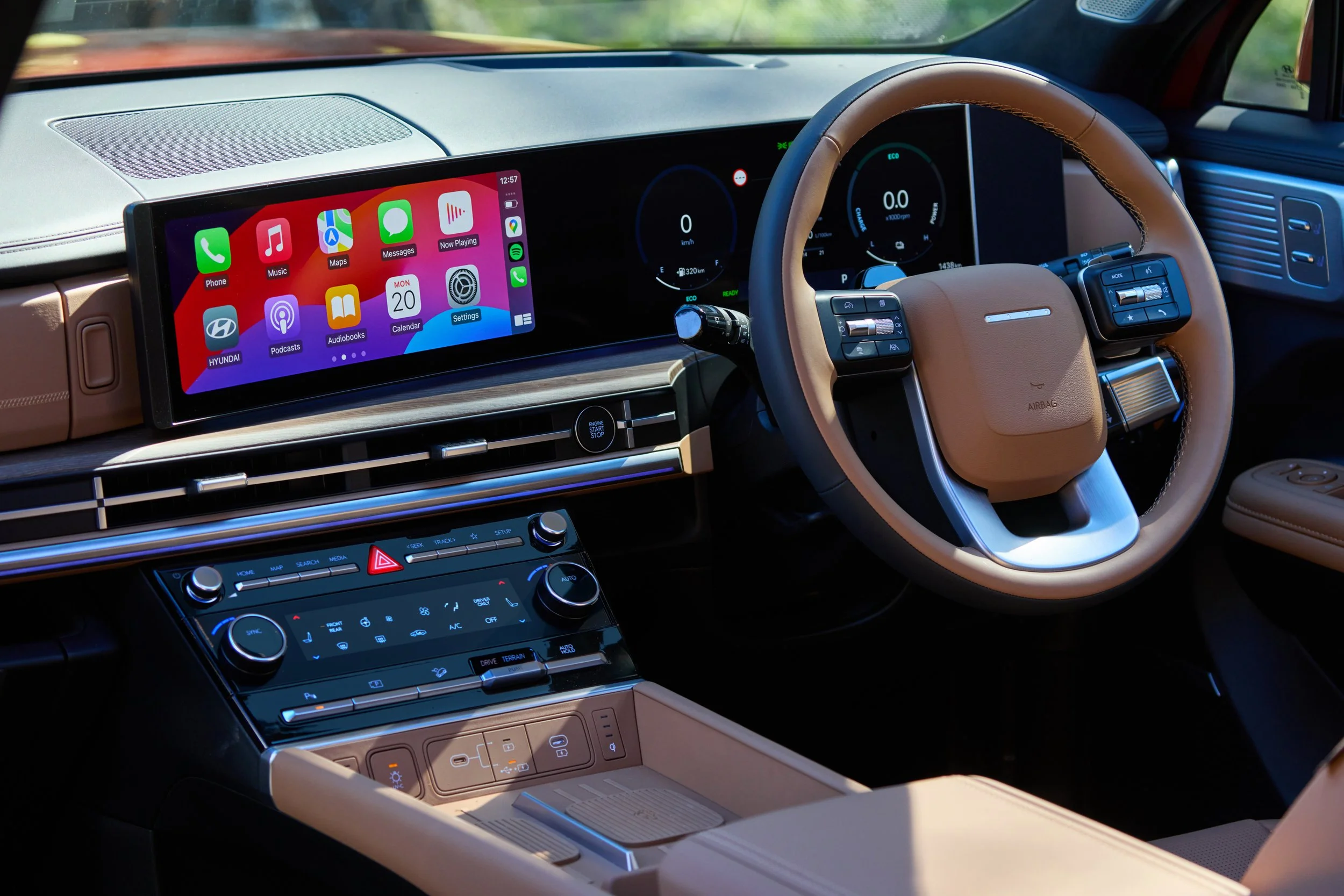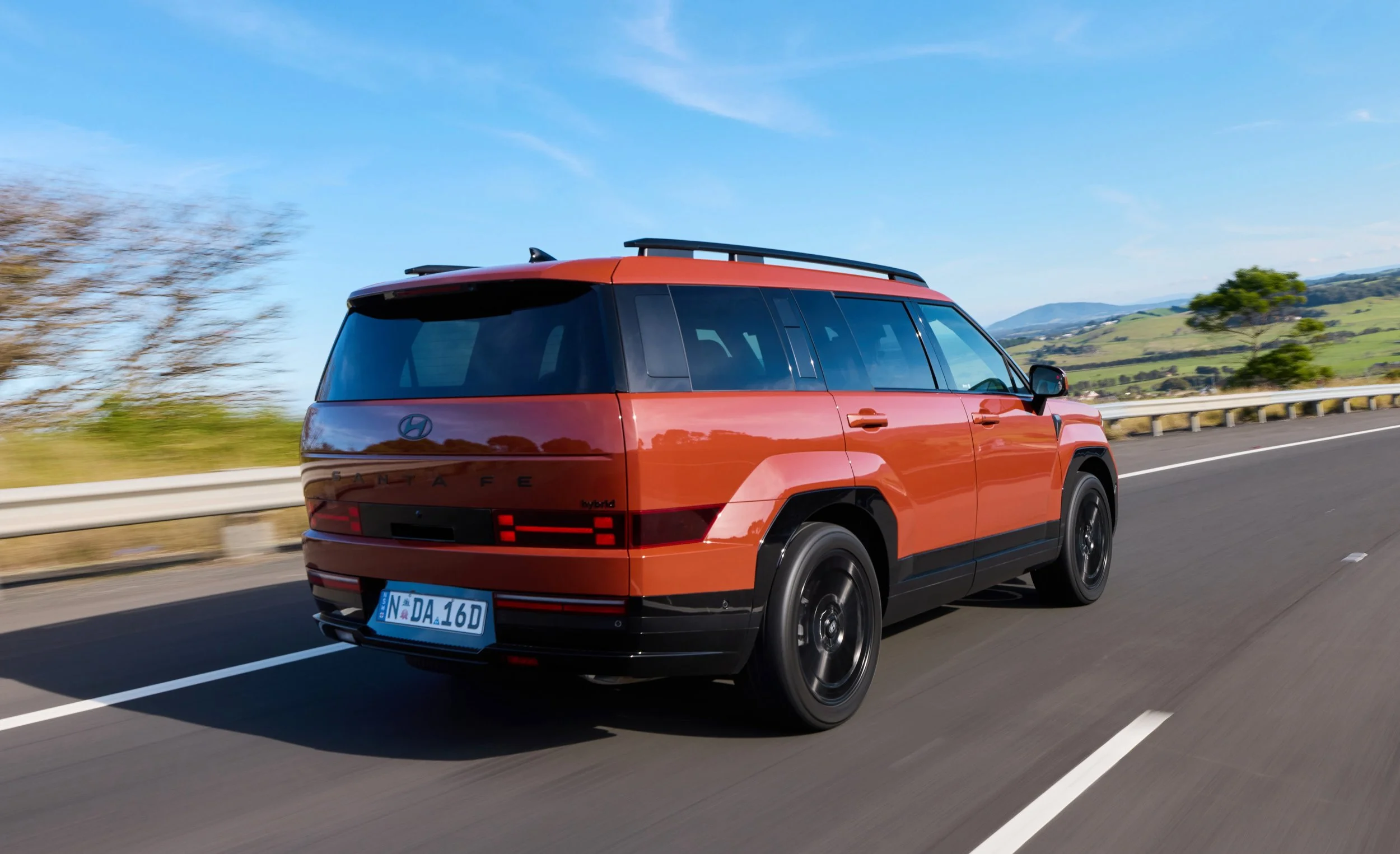Santa Fe goes large - and prices climb as well
/Detail announcement for new generation model reinforces it being a start-afresh pitch.
PRICING for the latest Hyundai Santa Fe ahead of its on-sale next month puts the core family wagon into the six figure zone for the first time, unless you’re an early bird buyer.
The new range delivers a completely fresh car that spans three derivatives, the entry Active for $84,990, the Limited at $96,990 and a range-topping Calligraphy (pictured), which at $104,990 becomes the first Santa Fe on offer for more than $100k. For the time being, though, there’s a launch promotion that removes $10,000 from those stickers.
All are all-wheel-drive and all run a new 1.6-litre petrol hybrid drivetrain in a larger, boxier, bolder body with more equipment and technology than its predecessor. It is safer and more advanced than before.
The Active and Limited are seven seaters; the Calligraphy can format with seven seats - as in two chairs up front, then benches behind - or with six individual chairs, a type-first.
However, all this advancement comes with a hit to its practicality - one effect go diesel retiring after 14 years’ service is that the towing rating takes a pummelling - and also massive price lift when outgoing and incoming full recommended retails are considered.
Even though the Active at special introductory price is a $74,990 buy, it even then still sites $21,000 above its equivalent in the old range.
The old line’s top dog was also a Calligraphy - a nameplate introduced a year ago as a limited edition - and that car sold for $94,990, though in March it discounted to $82,990.
Also, at the moment the brand’s largest sports utility wagon, the Palisade is delivering as a bigger, more spacious proposition, with that 2.2-litre diesel, for as low as $86,990, this being a special price that removes $20k from its regular recommended retail that would make it $2000 dearer than the new Calligraphy.
Diesel being expunged from the new Santa Fe is a permanent move, regardless that it has been the dominant choice through four previous generations, standing tall even after Hyundai NZ brought in petrol hybrid with the old shape in hope that tech would alter buying patterns. It didn’t: Up to 70 percent of buy-in has been for the diesel.
What impact the loss of compression ignition will make to the nameplate is anyone’s guess; but it’s a gamble. Santa Fe has been of primary importance, having achieved more than 25,000 NZ sales since the first arrived in 2000.
The new model delivers a longer list of standard features, with 20-inch alloy wheels, LED headlights, dual 12.3-inch interior screens, dual-zone climate control, and a power-adjustable driver's seat now standard across the range.
Semi-autonomous Highway Driving Assist software capable of centring the car in its lane, and assisting the driver with lane changes, also involves, though not on everything.
The new powertrain marries a 1.6-litre turbo four-cylinder petrol engine, a 44.2kW electric motor and 1.49kWh lithium-ion polymer battery pack. In developing 172kW and 376Nm combined, it makes 3kW and 26Nm more than the previous Santa Fe hybrid.
It is matched with a six-speed automatic transmission; one of the few carryover ingredientss from the previous design.
The drivetrain helps lift the type’s environmental standing - with impressively lower CO2 counts and improved optimal economy.
Hyundai in South Korea claims 6.5 to 7.6 litres per 100km. Hyundai NZ has yet to provision figures sorted for the WLTP-3 scale used here.
The potentially incoming 2.5-litre is factory-cited 9.3 to 10.5L/100km and the NZ market claim for the diesel has been 7.1 to 7.8 litres.
Those present owners who like towing will need to reconsider what goes on the hook.
Whereas the 148kW and 440Nm diesel Kiwis loved was rated to haul 2500 kilograms braked - not enough to put it in the big leagues, but handy nonetheless - this hybrid will draw the line at the same limit imposed on the outgoing version, a potentially less useful 1650kg.
That’s lineball with the next-size-down Tucson, which is rated from 1650kg to 1900kg depending on the derivative, and only slightly ahead of the Kona.
Emissions are improved, with 145 grams per kilometre on the WLTP scale. The diesel at best delivered 160g/km. The V6 was the dirty one, with 244g/km.
There’s still talk a petrol-only 2.5-litre turbo model may join the range at a later date, ostensibly to succeed the V6 that departed some time ago. It develops 206kW and 422Nm – up from 200kW/331Nm from that old six – matched with an eight-speed dual-clutch automatic transmission.
The new car is tangibly larger than the vehicle it replaces; at 4830mm long, 1720-1780mm tall (depending on model) and riding on a 2815mm wheelbase it is 45mm longer overall, 20mm taller, 50mm longer between the wheels. Only width of 1900mm is consistent.
That upsize poses no physical threat to Palisade, which builds off a common platform as the outgoing Santa Fe, seats seven or eight, maintains that four-cylinder diesel as an alternate to a a 3.5-litre petrol V6 and sources from North America.
Highlights of the new Santa Fe’s design include distinctive H-shaped LED headlight and tail-light designs, 21-inch wheels on top-of-the-range models, prominent wheel arches, and blacked-out window pillars for a 'floating roof' look.
Inside, a pair of 12.3-inch screens – one infotainment touchscreen, and one instrument display – have been merged into a curved panel across much of the dashboard, running Hyundai's latest software with over-the-air updates, Apple CarPlay and Android Auto.
The steering wheel and climate-control panel – with two large dials flanking a 6.6-inch colour touchscreen – are reminiscent of those used by Range Rover.



















